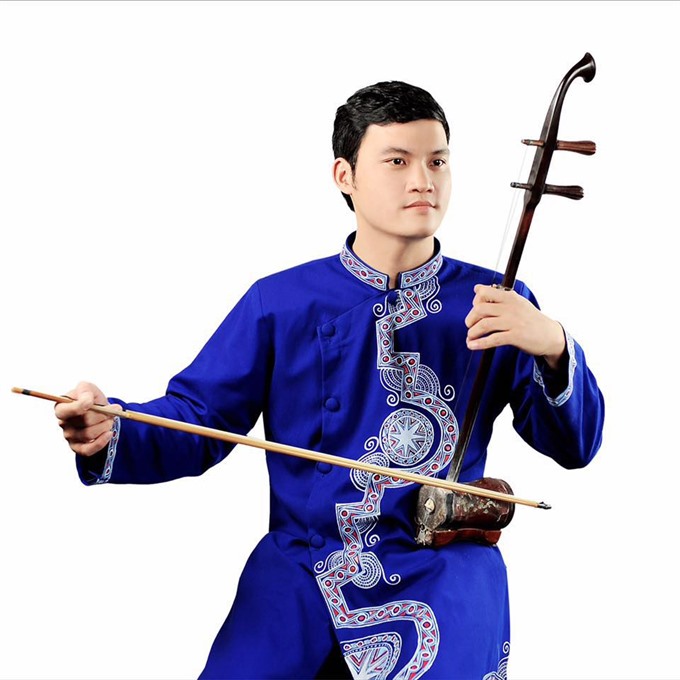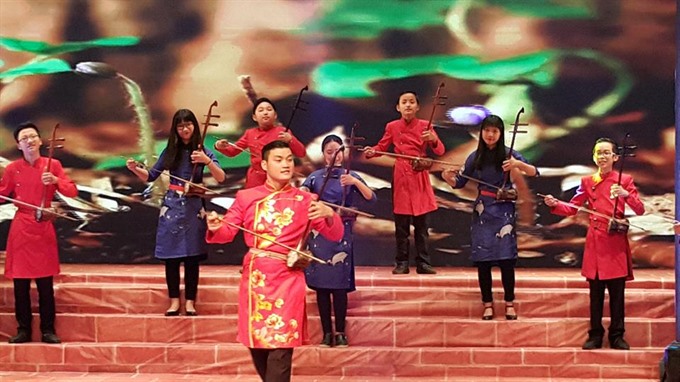 Features
Features

The đàn nhị, a bowed string instrument with two strings, is a multi-purpose fiddle in the vast treasury of Vietnamese traditional musical instruments. Noting that artists were getting stuck in the same old ways of playing the đàn nhị, Trần Văn Xâm, a lecturer on the instrument at the Việt Nam National Academy of Music, decided to make a change.
 |
| Takes two: Xâm (right) with violinist Hoàng Rob in a duet performance. — Photo saigongiaiphong.net |
by An Vũ
The đàn nhị, a bowed two-string instrument, is a multi-purpose fiddle in the vast treasury of Vietnamese traditional music.
Also known as the Vietnamese fiddle, the instrument’s size, shape and materials differ according to the ethnic group which uses it.
The đàn nhị has a range of two octaves, with a bright, clear, soft sound. To change the timbre or reduce the sonority of the instrument, the artist traditionally uses his left knee or a big toe to cover the instrument’s sound box. By so doing it creates a reverberating sound, defining the closed, even melancholic state of mind of the singer with its dark, cold tonal effect.
The instrument’s unique features alloww it to produce a range of performances, with a special timbre, and give it the ability to reflect various emotional states. As a result, the đàn nhị has appeared in multiple music genres. The instrument is played in both folk music and European-style compositions, from solos and duets to trios as well as chamber and theatrical music. This flexibility is rarely achieved by any other traditional music instruments.
The book Nhạc khí dân tộc Việt Nam (Traditional Vietnamese Musical Instruments), written by composers Lê Huy and Huy Trân, reads, “Đàn Nhị has been part of many past and modern orchestral organisations, such as phường bát âm (eight-instrument band), nhã nhạc (royal music), chầu văn (folk music combining trance singing with dancing), tài tử (amateur singing) and xẩm (music performed by blind buskers). Even in tuồng (classical drama), chèo (traditional opera) and cải lương (reformed theatre), the instrument plays a major role.
Noting that artists were getting stuck in the same old ways of playing the đàn nhị, Trần Văn Xâm, a lecturer on the instrument at the Việt Nam National Academy of Music, decided to make a change.
Since the opening of Hà Nội’s Old Quarter walking street in 2015, Xâm’s music band Nét Nhị Cầm (The Stroke of Đàn Nhị) has performed five consecutive shows on every weekend. Crowds stop to listen as the sound of the instrument echoes through the streets.
“In the revived Old Quarter, the đàn nhị was honoured by cultural authorities and audiences, as Nét Nhị Cầm discovered. It all started with an invitation from the Old Quarter’s managing board. Now, from the new ’walking streets’ to Facebook, young people are expressing their affection for the instrument in increasing numbers. The number of students applying to the academy is unparalleled,” Xâm said.
Xâm’s band has 20 members, most of them in their 20s, all playing the đàn nhị, while five others play different instruments as back up. Along with romantic music and folk music, they also rock out to Luis Fonsi’s Despacito and other modern hits.
In each show, Xâm and his band performed 30 pieces. Despite the cool spring weather, he is drenched with sweat each night. “When I am standing with the audience, I play like I’m going into a trance. I never feel exhausted,” he said. Locals and foreigners alike stop to listen to him play, dropping money into their baskets.
“Nét Nhị Cầm is possibly the most loved street band so far,” said Trịnh Ngọc Phương, who attends the band’s performances regularly.
 |
| Master: Xâm is not only loved for his instrument’s sound but also for his stage presence while performing, with his body swinging wildly and his face twisted in rapture. — Photo Courtesy of Trần Văn Xâm |
Xâm recalled with pleasure the times his band was visited by former deputy prime minister Phạm Gia Khiêm and his friends, noting the official had even contributed tips to their basket. In another fond memory, a cleaner was immersed in his performance; he would leave tips for the band and keep returning for each performance.
“That made me feel like our music reaches all social classes, because the music is composed for the đàn nhị, and the đàn nhị is an instrument of the common people,” Xâm said.
Fans have told Xâm that they not only love his instrument’s sound, but also his stage presence while performing, with his body swinging wildly and his face twisted in rapture, something he said he inherited from his teachers, People’s Artists Nguyễn Thế Dân and Phạm Hồng Dót, and that he had consciously developed since the age of 15.
“To a professional, the đàn nhị sounds like a violin in many ways because its range and flexibility is similar. It can be played in scholarly or folk music. If you know how to use it correctly, it can be a powerful tool. It can express sorrow, joy – all the emotions a human being can have. As some people also consider it a funerary instrument, they do not want to update it or change their way of playing it, so it has kept a reverential feeling," Xâm said.
 |
| Chamber music: Xâm is humble in everything he does, whether he is performing in a major event or an intimate show. — Photo Courtesy of Trần Văn Xâm |
 |
| Silver screen: Xâm and his students perform on a TV show. — Photo Courtesy of Trần Văn Xâm |
Starting as an 11-year-old boy who inherited the gift for playing the đàn nhị from his father, master artist Trần Đức Chinh, Xâm has become one of the top đàn nhị players, but he is still humble and simple in everything he does, whether performing at a major event or an intimate show. Adored by his fans, he is considered the role model by pop singers such as Tuấn Hưng and young violinist Hoàng Rob and has been invited to feature in their shows.
“I think it is really amazing that young artists today have found ways to combine contemporary and traditional music and instruments. It is one of the ways we can preserve the đàn nhị and other folk instruments. I know the popular world music has become a trend today, but I prefer performing jazz and rock or traditional music, rather than world music like other artists,” he said.
Xâm said he had two albums: an academic album titled Đàn Chim Việt (The Vietnamese Bird Flock) completed two years ago, and a pop album titled Về Quê (Return to the Country) will be available in May.
Although he has received many awards for excellence as an artist and lecturer of the đàn nhị and for his dedication to his beloved students, he claims that, for the foreseeable future, he wants to be a teacher, nurturing the country’s talent, and an artist who lives life to the fullest with the đàn nhị.
“Although I have performed abroad many times, and I know many young artists want to live abroad to develop their career, my wish is to stay in Việt Nam to teach and perform the đàn nhị. It is my life – what I was born to do. At present, the number of students in our đàn nhị class has risen from 30 per cent to 70 per cent. I also send my students to perform in artistic programmes, so they can start forming their careers. The best way to preserve the đàn nhị is to record albums and present them to an audience. The audience is the best judge for all artists,” said Xâm. VNS




